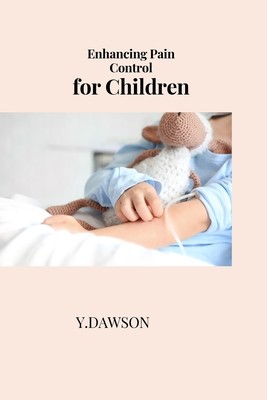
- We will send in 10–14 business days.
- Author: Y Dawson
- Publisher: Salman Khan
- ISBN-10: 0236854437
- ISBN-13: 9780236854431
- Format: 15.2 x 22.9 x 0.7 cm, minkšti viršeliai
- Language: English
- SAVE -10% with code: EXTRA
Reviews
Description
Pain control is an essential aspect of medical care, and it is especially crucial for children who are undergoing medical procedures. Children may experience pain due to illness, injury, or medical procedures, and effective pain control can help reduce their distress, improve their recovery time, and enhance their overall well-being.
Here are some ways in which pain control can be enhanced for children:
- Use age-appropriate pain assessment tools: Pain assessment is the first step in effective pain control. Age-appropriate pain assessment tools should be used to assess a child's pain level accurately. For infants and young children, observational tools, such as the FLACC scale, can be used. For older children, self-reporting tools, such as the Faces Pain Scale, can be used.
- Non-pharmacological interventions: Non-pharmacological interventions, such as distraction techniques, music therapy, and relaxation techniques, can be effective in reducing pain and anxiety in children. These interventions can be used alongside pharmacological interventions to enhance pain control.
- Pharmacological interventions: Pharmacological interventions, such as analgesics, can be used to manage pain in children. The choice of analgesic should be based on the child's age, weight, and medical history. It is essential to use the appropriate dose and route of administration to ensure effective pain control and minimize side effects.
- Multimodal approach: A multimodal approach to pain control, which combines different pain control strategies, can be effective in enhancing pain control in children. This approach may involve the use of pharmacological interventions, non-pharmacological interventions, and psychological interventions.
- Parental involvement: Parental involvement can be crucial in enhancing pain control in children. Parents can provide comfort, support, and reassurance to their child during medical procedures, which can help reduce pain and anxiety. Parents can also be involved in the decision-making process regarding pain management strategies.
In summary, enhancing pain control for children requires a comprehensive approach that includes appropriate pain assessment, the use of non-pharmacological and pharmacological interventions, a multimodal approach, and parental involvement. By implementing these strategies, healthcare professionals can ensure that children receive the best possible pain control during medical procedures.
EXTRA 10 % discount with code: EXTRA
The promotion ends in 21d.11:17:35
The discount code is valid when purchasing from 10 €. Discounts do not stack.
- Author: Y Dawson
- Publisher: Salman Khan
- ISBN-10: 0236854437
- ISBN-13: 9780236854431
- Format: 15.2 x 22.9 x 0.7 cm, minkšti viršeliai
- Language: English English
Pain control is an essential aspect of medical care, and it is especially crucial for children who are undergoing medical procedures. Children may experience pain due to illness, injury, or medical procedures, and effective pain control can help reduce their distress, improve their recovery time, and enhance their overall well-being.
Here are some ways in which pain control can be enhanced for children:
- Use age-appropriate pain assessment tools: Pain assessment is the first step in effective pain control. Age-appropriate pain assessment tools should be used to assess a child's pain level accurately. For infants and young children, observational tools, such as the FLACC scale, can be used. For older children, self-reporting tools, such as the Faces Pain Scale, can be used.
- Non-pharmacological interventions: Non-pharmacological interventions, such as distraction techniques, music therapy, and relaxation techniques, can be effective in reducing pain and anxiety in children. These interventions can be used alongside pharmacological interventions to enhance pain control.
- Pharmacological interventions: Pharmacological interventions, such as analgesics, can be used to manage pain in children. The choice of analgesic should be based on the child's age, weight, and medical history. It is essential to use the appropriate dose and route of administration to ensure effective pain control and minimize side effects.
- Multimodal approach: A multimodal approach to pain control, which combines different pain control strategies, can be effective in enhancing pain control in children. This approach may involve the use of pharmacological interventions, non-pharmacological interventions, and psychological interventions.
- Parental involvement: Parental involvement can be crucial in enhancing pain control in children. Parents can provide comfort, support, and reassurance to their child during medical procedures, which can help reduce pain and anxiety. Parents can also be involved in the decision-making process regarding pain management strategies.
In summary, enhancing pain control for children requires a comprehensive approach that includes appropriate pain assessment, the use of non-pharmacological and pharmacological interventions, a multimodal approach, and parental involvement. By implementing these strategies, healthcare professionals can ensure that children receive the best possible pain control during medical procedures.


Reviews